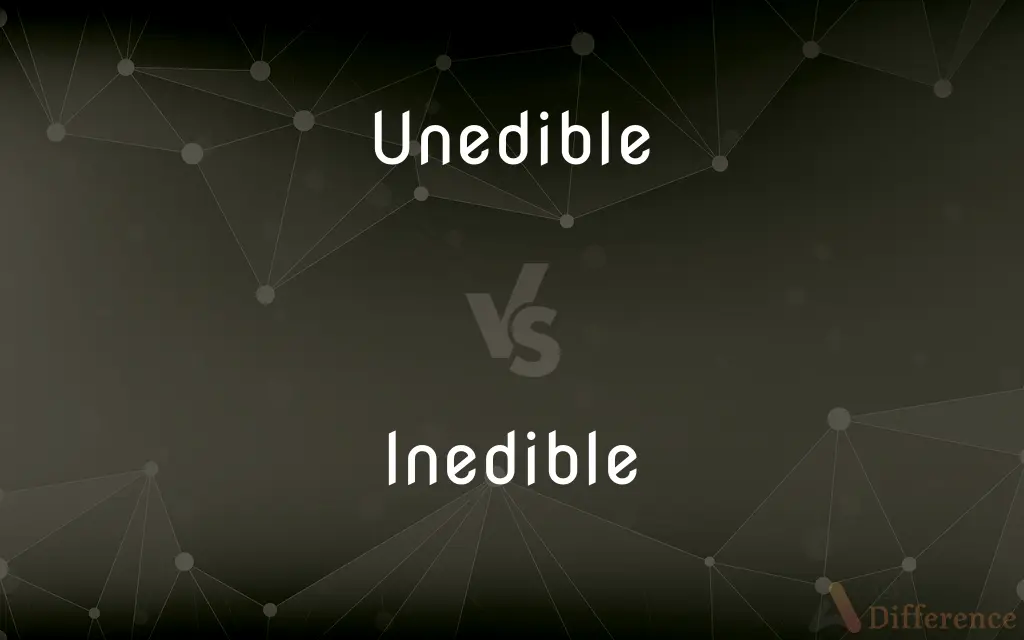Unedible vs. Inedible — What's the Difference?
By Tayyaba Rehman — Updated on September 4, 2023
"Unedible" is an uncommon, nonstandard form of "inedible," both meaning not suitable for consumption. "Inedible" is the widely accepted term.

Difference Between Unedible and Inedible
Table of Contents
ADVERTISEMENT
Key Differences
"Unedible" and "inedible" both refer to something that cannot or should not be eaten. However, their usage and acceptance in the English language differ considerably.
The prefix "un-" in "unedible" is a negation, implying that something isn't fit for consumption. However, "unedible" is not commonly found in formal writing or literature.
On the other hand, "inedible" with the prefix "in-" is a standard adjective used to describe items that are not fit for eating. Its usage is widespread in both speech and writing.
It's crucial to note that while some may use "unedible" colloquially, "inedible" remains the preferred term in dictionaries, publications, and formal conversations.
Both words derive from the verb "eat." However, when describing something unsuitable for consumption, "inedible" is the recommended choice.
ADVERTISEMENT
Comparison Chart
Definition
Not standard English, means not fit for consumption
Standard English, means not suitable for consumption
Commonality
Less common
Widely used
Usage
Casual conversations
Both formal and informal contexts
Prefix
"Un-"
"In-"
Dictionary Inclusion
Rarely found
Commonly found
Compare with Definitions
Unedible
Not palatable or enjoyable to eat.
The fish was so overcooked, it turned unedible.
Inedible
Not suitable or safe for eating.
These berries are inedible and can be toxic.
Unedible
Not meant for human consumption.
These are unedible decorations for display only.
Inedible
Lacking taste or palatability.
The meat turned inedible after being overcooked.
Unedible
A nonstandard term for something not suitable to eat.
This plastic is unedible and should be kept away from kids.
Inedible
Of a quality or nature that cannot be consumed.
These inedible additives are used only for coloring.
Unedible
An informal way to describe something tasteless or unpleasant.
The cake tastes unedible after being in the fridge for so long.
Inedible
Not intended for human consumption.
The inedible parts of the fruit should be discarded.
Unedible
A colloquial term implying something shouldn't be eaten.
That moldy bread looks unedible.
Inedible
Not able to be eaten without harm or discomfort.
Some mushrooms are inedible and poisonous.
Unedible
Not edible.
Inedible
Not fit or suitable for eating
An inedible variety of mushroom
Inedible
Unfit to be eaten; not edible.
Inedible
Not edible; not appropriate, worthy, or safe to eat
Inedible
Anything inedible; that which is not a foodstuff.
Inedible
Not edible; not fit for use as food.
Inedible
Not suitable for food
Common Curiosities
Is "unedible" a standard term in English?
No, "inedible" is the standard term. "Unedible" is nonstandard.
Why is "inedible" more accepted than "unedible"?
"Inedible" has a longer history of usage in English and is recognized in dictionaries.
Do both words mean the same?
Essentially, yes. Both describe something not fit for consumption.
Do both words have the same origin?
Yes, both derive from the verb "eat."
Which is more commonly used, "unedible" or "inedible"?
"Inedible" is more commonly used.
Do both terms refer only to food?
Primarily, but they can describe anything one might consider consuming.
Can I use "unedible" in formal writing?
It's recommended to use "inedible" in formal contexts.
Can "unedible" be used in casual speech?
While some might use it in casual contexts, "inedible" is still the preferred term.
Is "unedible" found in dictionaries?
It's rarely found, whereas "inedible" is common.
Is it incorrect to use "unedible"?
While understood, "inedible" is the grammatically and lexically preferred term.
Are there other words similar to "unedible" that aren't standard?
Yes, English has many nonstandard forms, but they vary based on context.
Are there certain foods termed "unedible" but are eaten in some cultures?
The term would be "inedible," and yes, some foods considered inedible in one culture might be consumed in another.
Are the meanings of the prefixes "un-" and "in-" similar?
Both are negative prefixes, but "in-" is more commonly used for adjectives like "inedible."
Are "unedible" and "inedible" synonyms?
While their intent is similar, only "inedible" is the standard term.
Can "unedible" ever become standard English?
Language evolves, but currently, "inedible" is the accepted standard.
Share Your Discovery

Previous Comparison
Transferor vs. Transferee
Next Comparison
Total vs. OverallAuthor Spotlight
Written by
Tayyaba RehmanTayyaba Rehman is a distinguished writer, currently serving as a primary contributor to askdifference.com. As a researcher in semantics and etymology, Tayyaba's passion for the complexity of languages and their distinctions has found a perfect home on the platform. Tayyaba delves into the intricacies of language, distinguishing between commonly confused words and phrases, thereby providing clarity for readers worldwide.














































